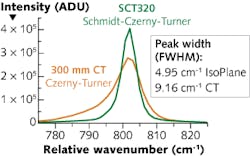The Schmidt-Czerny-Turner (SCT)-based, single-stage IsoPlane spectrograph from Princeton Instruments (Trenton, NJ) has zero astigmatism at all wavelengths across the entire focal plane. While the 802 cm-1 Raman shift band of cyclohexane measured with a traditional Czerny-Turner spectrograph has a peak width of 9.16 cm-1, the same peak measured with an IsoPlane under similar conditions has improved resolution with a peak width of 4.95 cm-1. And because SCT spectrographs have high fluence (more photons focused on fewer pixels), improved signal-to-noise ratio is demonstrated by the fact that the cyclohexane peak height measured with an SCT IsoPlane is almost twice that measured with a CT spectrograph.
When an IsoPlane is interfaced to a low-frequency XLF-CLM Raman spectroscopy module from Ondax (Monrovia, CA), which uses volume holographic gratings (VHGs) as Rayleigh line filters giving peaks as close as 10 cm-1 from the Rayleigh line, measurement of low-frequency Raman spectra is possible. While most spectrographs can detect Raman shifts from 200 to 4000 cm-1, detection of shifts from 10 to 200 cm-1 and closer to the Rayleigh line often requires expensive and complex triple monochromators to reject most of the Rayleigh scattering. Measurements of the low-frequency spectral of several amino acids using the IsoPlane VHG system found the expected number of peaks in agreement with the literature, as well as many additional peaks that appear to be new to science. Contact Brian Smith at [email protected].
About the Author

Gail Overton
Senior Editor (2004-2020)
Gail has more than 30 years of engineering, marketing, product management, and editorial experience in the photonics and optical communications industry. Before joining the staff at Laser Focus World in 2004, she held many product management and product marketing roles in the fiber-optics industry, most notably at Hughes (El Segundo, CA), GTE Labs (Waltham, MA), Corning (Corning, NY), Photon Kinetics (Beaverton, OR), and Newport Corporation (Irvine, CA). During her marketing career, Gail published articles in WDM Solutions and Sensors magazine and traveled internationally to conduct product and sales training. Gail received her BS degree in physics, with an emphasis in optics, from San Diego State University in San Diego, CA in May 1986.
